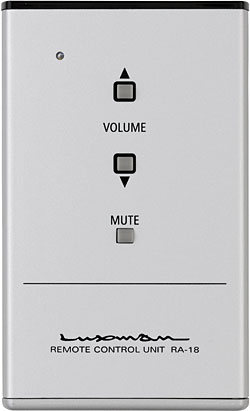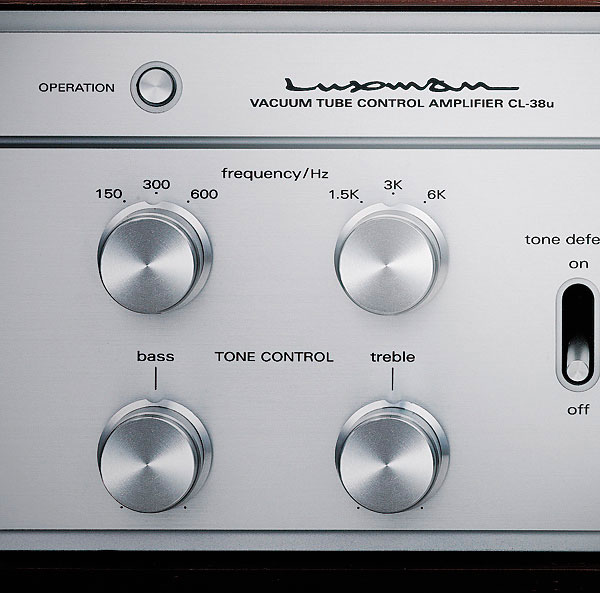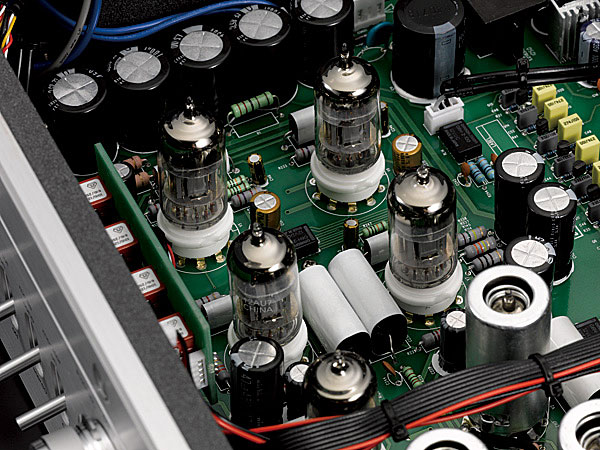| Columns Retired Columns & Blogs |
these reviews and content in general are hitting stereophile.com so quickly now I'm beginning to wonder whether I still need a digital subscription.
A final installation note: The molded plug of the AC cord supplied with the Classic CL-38u has only two prongs; similarly, although the preamp is fitted with an IEC socket, said socket lacks a third contact—and the corresponding portion of the AC cord is as smooth and undisturbed as a Mexican tetra's eye socket. For those reasons if no others, it would seem that aftermarket AC cords need not apply.
 Listening
Listening
Fully warmed up, the Classic CL-38u presented music with natural, realistic warmth and color, and fine bass-to-treble balance. Its perspective was neither recessed nor excessively forward, and its spatial presence tended toward the larger end of the scale.
Touch and impact were very good. In the recording of Strauss's Metamorphosen by Neville Marriner and the Academy of St. Martin-in-the-Fields (LP, Argo ZRG 604), pizzicato notes in the double basses, while timbrally rich almost—but not quite—to the point of plumminess, were not at all lacking in tactile snap. A related characteristic was the CL-38u's sheer speed and clarity of musical timing. Up-tempo jazz and pop benefited from that quality, of course, but so did classical music, as with the well-known recording by Charles Munch and the Boston Symphony Orchestra of Franck's Symphony in d (LP, RCA Living Stereo LSC-2131). Munch's flexible, turn-on-a-dime tempos were explicitly put across by the Luxman, as were the momentum and sheer power of the orchestra in this performance's many accelerandi.
Equally impressive with large-scale music were the Luxman's dramatic expressiveness, and its ability to remain unfazed during the highest and densest peaks. The CL-38u's handling of the many unexpectedly powerful crescendi in Metamorphosen was especially notable: The sound remained free of audible strain, even as the music was, emotionally, nearly overwhelming. On the few occasions when I allowed playback levels to get out of hand, the Luxman responded not with harshness but with a bit too much texture. For example, with Georg Solti and the London Symphony Orchestra's recording of Mahler's Symphony 2 (2 LPs, Decca/Speakers Corner SET 325/6)—the rare Decca classical recording that sounds just a little too hi-fi to my ears—my recklessness with the volume control yielded a slight excess of grain in the sounds of loudly played brass instruments.

The line between getting the right amount of detail out of a recording and an excess of same is similar to the line between enjoying the outdoors during temperate weather and being eaten alive by mosquitos; the Classic CL-38u was, I'm happy to say, on the correct side of that border. While the Luxman was in my system, I spent more than one evening with the lovely Soria Series album The Golden Age of English Lute Music, by guitarist/lutenist Julian Bream (LP, RCA Living Stereo LDS-2560), and was impressed—not to mention entertained, even charmed—by how the Luxman provided just the right percussiveness to each note without sounding mechanical or hi-fi. In the Luxman's hands, those attacks were followed by the realistic blooming of individual notes, with very good color and physicality. Additionally, the CL-38u's facility with spatial detail made it easy to hear and appreciate the simple techniques used to record this music, and to hear differences between certain selections in miking technique and miking distances—as between the gorgeous Thomas Morley Pavan, and the notably more distantly recorded Batell Galliard of John Dowland.
My midlife King Crimson fascination endures, so much so that I sought out and found, for $20, a UK import LP of the band's fourth album, Islands (LP, Island ILPS-9175). Since its arrival, I haven't once filed it away—and it sounded fine through the CL-38u. In "The Letters," the textures of Mel Collins's saxophones and Ian Wallace's brushed drums, the latter heavily compressed in the manner of the day, were portrayed beautifully by the CL-38u. The Luxman was also good at separating from one another the sounds of superficially similar instruments—as in the title track's juxtaposition of the eerie, otherworldly Mellotron with the earthy, more richly textured sounds of Robert Fripp's harmonium.

Neil Young's Live at the Cellar Door (LP, Reprise 535854-1) is surely one of the biggest records in my collection: not only for the huge piano sound in some songs but for the similarly big sound of Young's acoustic guitar in the rest of this solo-performance album. Reproduced correctly, Young's old Martin dreadnought should have not only good scale but also a wide range of intensities, with peaks that border on the out-of-control—as in "Don't Let It Bring You Down," where the strings are tuned down a full step, and the bottom string is tuned down yet another full step, to C. The CL-38u stood alongside my own Shindo Masetto in allowing that simple acoustic guitar to sound almost dangerous—and while I hope and intend not to overuse this reference, I will add that my dog, who barks at the sounds of big trucks rolling through the village, flew into a rage when I played this song at only a moderate level.
Based on listening with CD and USB DAC sources, the CL-38u's line inputs offered the same sonic characteristics as its phono section: good balance, very good dynamic range, and a timbral presentation that left little doubt as to the Luxman's active components of choice. As with most other gear of my acquaintance, Loudon Wainwright III's The BBC Sessions (AIFF file ripped from CD, BBC SFRSCD073) sounded somewhat brittle, the Luxman refusing to round off its edges, but with a nice sense of immediacy and very good musical momentum and flow for digital playback. And after listening to a vinyl version of violinist David Oistrakh and Jascha Horenstein's recording of Bruch's Scottish Fantasia, with the London Symphony (LP, Decca/Speakers Corner SXL 6035), I played the same thing on CD (London/Classic Compact Discs CSCD 6337), and again luxuriated in the Luxman's realistically warm way with strings and excellent sense of scale.
Conclusions
Here's a pretty safe bet: To the most casual observer, the Luxman Classic CL-38u is either the preamp with the wooden cabinet or the preamp with the tone controls. Both reactions are understandable, but each does this product a disservice. First and foremost, the CL-38u is a distinctly musical product whose sonic strengths happened to nicely mesh with my own priorities. As for the rest . . . well, I could take or leave the tone controls, but I admit that I was delighted to have a mono switch and a balance control, neither of whose use smudged the sound.
And $4200 for a full-function (line plus phono), Japanese-made preamplifier of this caliber is not just a good value: It's an exceptional value.
Perhaps because the cosmetics of the Classic CL-38u and my Shindo Masetto preamp are poles apart—the only physical characteristic the two products have in common is the very welcome fact that neither is any bigger than it needs to be—I was a little surprised at how effectively the former stepped in for the latter. And after a couple of months with the Luxman in my system, I was still in no great rush to push it out the door. Throughout that time, I derived no less pleasure from my music collection than I'm used to with the Shindo. That may sound to some like faint praise, but any number of my reviewer colleagues will agree that the products that most deeply impress us are often the ones of which we find ourselves saying, "Yeah, I could live with that."
I could very easily live with the Luxman Classic CL-38u. Strongly recommended.

these reviews and content in general are hitting stereophile.com so quickly now I'm beginning to wonder whether I still need a digital subscription.

these reviews and content in general are hitting stereophile.com so quickly now I'm beginning to wonder whether I still need a digital subscription.
This is due to how the calendar crumbles each month.
John Atkinson
Editor, Stereophile

I was in retail in Canterbury in the early eighties just as Luxman stopped making rather lovely things like the L80V http://www.hifiengine.com/images/model/luxman_l-80_front_panel.jpg which were replaced with bland industrial looking gear. Good to see them back. Thanks for the heads up on the timing, frankly Art is worth the price of admission alone.

you've got going on there, Art. I think you'd have to be blind to mistake that Luxman for a Marantz 7.Other than the fact they're both tube preamps with some switches in the middle, I fail to see any cosmetic resemblance whatsoever. the panels are completely different colors, the Marantz cabinet was walnut, the Marantz switches were old fashioned toggles with bakelite knobs,the power switch was an old fashioned slide switch, etc. BTW "C" just meant it came with the cabinet. There was never a Marantz 7A or B., and officially it was always known simply as the Marantz 7.

Yeah but the digital subscription is so cheap I feel comfortable knowing that Art and others at Stereophile are being supported to continue reviewing such great products. Still have my old Luxman L-450 with digital tuner and cassette deck at my parent's place, after all these years they still run great. Love Luxman's gear and have come full circle on their turntable, once thought it ugly now think it is quite attractive.

I noticed JA mentioned in the measurement column the CL-38U's polarity is reversed on MC loads. How pervasive is this on other equipment? If it does occur, then shouldn't that information be in the review copy? It's my understanding that polarity can be corrected by reversing the sources RCA/XLR into the troubled (?) unit. Is that true? I admit to knowing very little about checking and compensating for polarity would love further explanation whether that be in the pages of Stereophile or elsewhere. Thanks!

When RELATIVE POLARITY is miswired the left and right speakers will not agree as to whether the speaker is moving IN or OUT.
One speaker will be playing INWARD notes and the other speaker will be playing OUTWARD notes.
That is because the plus and minus terminals on ONE speaker have the leads REVERSED somewhere in the chain. Unless you bought some really BAD stuff this has occurred by Operator Error and YOU wired one speaker BACKWARDS---YOUR bad.
Positive lead is wired to Minus terminal and Minus lead is wired to Positive terminal. On ONE speaker only.
What John caught is NOT this problem (which would really have messed up the sound terribly and made the bass sound weak as heck)...
John noticed ABSOLUTE POLARITY was miswired.
Which is when ALL the wires are hooked up to the WRONG terminals. On BOTH channels.
So your speakers would play together as they moved IN and OUT. BUT---they would play INTO their cabinets instead of OUT of their cabinets. The speakers would drive the sound INTO the box instead of driving the sound OUT to the air.
It all sounds a bit DEAD when you do that. Exactly as though you were making the sound play INTO the box instead of playing OUT into the room. MUFFLED. Very CLEAR. But MUFFLED.
But not terribly so. It is an effect you really have to pay attention to notice. And have really well set up gear in the first place.
And what is WORSE is that SOME recordings were accidentally encoded with everything reversed. AND BAD RECORDINGS WILL BE PLAYED CORRECTLY WHEN THE POLARITY IS ABSOLUTELY REVERSED.
Just to make all of us crazy. Haha.
But anyway---It is there. It is real.
But probably NOT the first thing you might hate about your new Stereo.
I once accused Benchmark of having their phase reversed on the DAC1. Their engineer called me back and said: "wrong." "It is NOT wired wrong."
Then I triple checked my setup and damn it---MINE was wired backwards.
Oh well. I will never live down the shame...
And life goes on.

Great article, great enough to make me want to buy one. However, the Luxman agent in Australia is not going to stock them, the Luxman agent in the UK is not going to stock them and "On a higher note" won't reply to my webform sales query. It is very annoying.